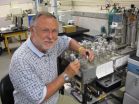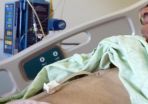(Press-News.org) INDIANAPOLIS -- Current colorectal cancer screening guidelines for individuals with first-degree relatives with precancerous colon polyps are based on studies that were not properly designed or were too limited to shape those guidelines, according to a new systemic review of research on the topic. The review authors call for new studies to measure the risk and identify the factors that modify it.
"We found that most studies that are cited for the risk for colorectal cancer when first-degree relatives -- parents, siblings or children -- have a precancerous polyp do not actually address the issue," said Regenstrief Institute investigator Thomas F. Imperiale, M.D., professor of medicine at the Indiana University School of Medicine and a research scientist with the Center of Excellence on Implementing Evidence-Based Practice at the Richard Roudebush VA Medical Center in Indianapolis. He is a gastroenterologist and clinical epidemiologist. "Screening is very important, and properly designed studies are needed to put science behind clinical screening recommendations."
Current guidelines for people who have first-degree relatives with precancerous polyps range from those of the U.S. Preventive Services Task Force, which makes no specific screening recommendation, to the guidelines of the American Cancer Society and the American College of Gastroenterology, which recommend a colonoscopy starting at age 40, or 10 years younger than the earliest diagnosis in the family (whichever comes first), and repeated every five years if the first-degree relative was diagnosed with a precancerous lesion before age 60.
The study, "Risk for Colorectal Cancer in Persons With a Family History of
Adenomatous Polyps" appears in the May 15 issue of the Annals of Internal Medicine. The systematic review was supported by the National Cancer Institute. David F. Ransohoff, M.D., of the University of North Carolina co-authored the paper with Dr. Imperiale.
"This is another important reason to know your family's health history," Dr. Imperiale said. "Until there is better evidence available, we suggest talking with your primary care physician and basing the decision on whether and how to be screened on the age of the youngest first-degree relatives with precancerous polyps and whether the precancerous polyps are classified as advanced or not."
A third to a half of Americans who undergo a colonoscopy are found to have one or more precancerous polyps, according to Dr. Imperiale, so it is extremely common to have a first-degree relative with a precancerous polyp. However, only 5 to 10 percent of these growths are advanced.
Until new, rigorous studies inform screening guidelines, Dr. Imperiale recommends an initial screening colonoscopy if the first-degree relative was younger than 60 and the polyp was advanced when found. If a first-degree relative was 60 or older when the advanced polyp was found, or any age when nonadvanced polyps were detected, he suggests that the family member be screened as average risk. Average-risk options include a high-sensitivity stool blood test annually or a colonoscopy every 10 years.
"The high prevalence of precancerous polyps highlights the need for new, well-designed studies to better understand the colorectal cancer risk of having a first-degree relative with a precancerous lesion -- differentiating between those that are advanced (and more serious) and those that are non-advanced," said Dr. Imperiale, a member of the IU Melvin and Bren Simon Cancer Center and a physician with IU Health. "If everyone who has a first-degree relative with a precancerous lesion is screened aggressively, the health care system would be overwhelmed, and it is possible that the net burdens would outweigh the benefits of screening. We need to make decisions based on better evidence."
NCI estimates that 51,690 men and women will die of cancer of the colon and rectum in 2012.
INFORMATION:
Colon cancer risk when a first-degree relative has precancerous polyps is not clear
2012-05-15
ELSE PRESS RELEASES FROM THIS DATE:
Measuring CO2 to fight global warming
2012-05-15
SALT LAKE CITY, May 14, 2012 – If the world's nations ever sign a treaty to limit emissions of climate-warming carbon dioxide gas, there may be a way to help verify compliance: a new method developed by scientists from the University of Utah and Harvard.
Using measurements from only three carbon-dioxide (CO2) monitoring stations in the Salt Lake Valley, the method could reliably detect changes in CO2 emissions of 15 percent or more, the researchers report in the online edition of the Proceedings of the National Academy of Sciences for the week of May 14, 2012.
The method ...
Economic growth in China has not meant greater life satisfaction for Chinese people
2012-05-15
Despite an unprecedented rate of economic growth, Chinese people are less happy overall than they were two decades ago, reveals timely new research from economist Richard Easterlin, one of the founders of the field of "happiness economics" and namesake of the Easterlin Paradox.
In 1990, at the beginning of China's economic transformation, a large majority of Chinese people across age, education, income levels, and regions reported high levels of life satisfaction. Sixty-eight percent of those in the wealthiest income bracket and 65 percent of those in the poorest income ...
Anthropologists discover earliest form of wall art
2012-05-15
Anthropologists working in southern France have determined that a 1.5 metric ton block of engraved limestone constitutes the earliest evidence of wall art. Their research, reported in the most recent edition of the Proceedings of the National Academy of Sciences, shows the piece to be approximately 37,000 years old and offers rich evidence of the role art played in the daily lives of Early Aurignacian humans.
The research team, comprised of more than a dozen scientists from American and European universities and research institutions, has been excavating at the site ...
Gastric feeding tubes may raise pressure ulcer risk
2012-05-15
PROVIDENCE, R.I. [Brown University] — A new study led by Brown University researchers reports that percutaneous endoscopic gastric (PEG) feeding tubes, long assumed to help bedridden dementia patients stave off or overcome pressure ulcers, may instead make the horrible sores more likely to develop or not improve.
The analysis of thousands of nursing home patients with advanced dementia appears in the May 14 edition of the Archives of Internal Medicine.
"This study provides new information about the risks of feeding tube insertion in people with advanced cognitive impairment," ...
Are people with HIV/AIDS more prone to sudden cardiac death?
2012-05-15
What is the connection, if any, between sudden cardiac death and people with HIV/AIDS? And can that knowledge help prolong their lives?
In a comprehensive, 10-year UCSF study, researchers found patients with HIV/AIDS suffered sudden cardiac death at a rate four times higher than the general population.
"As part of my ongoing research in 2010, we were looking at every instance of sudden death in San Francisco," said first author Zian H. Tseng, MD, an electrophysiologist and an associate professor of medicine in the UCSF Division of Cardiology. "I noticed that many of ...
Drug kills cancer cells by restoring faulty tumor suppressor
2012-05-15
A new study describes a compound that selectively kills cancer cells by restoring the structure and function of one of the most commonly mutated proteins in human cancer, the "tumor suppressor" p53. The research, published by Cell Press in the May 15th issue of the journal Cancer Cell, uses a novel, computer based strategy to identify potential anti-cancer drugs, including one that targets the third most common p53 mutation in human cancer, p53-R175H. The number of new cancer patients harboring this mutation in the United States who would potentially benefit from this ...
Study examines exercise testing in asymptomatic patients after coronary revascularization
2012-05-15
Asymptomatic patients who undergo treadmill exercise echocardiography (ExE) after coronary revascularization may be identified as being at high risk but those patients do not appear to have more favorable outcomes with repeated revascularization, according to a report published Online First by Archives of Internal Medicine, a JAMA Network publication. The article is part of the journal's Less is More series.
Cardiac events and recurrent ischemia (a temporary shortage of oxygen caused by impaired blood flow; identified in the study as new or worsening cardiac wall motion ...
Acupuncture appears linked with improvement in patients with chronic obstructive pulmonary disease
2012-05-15
According to a small clinical trial reported by investigators from Japan, acupuncture appears to be associated with improvement of dyspnea (labored breathing) on exertion, in patients with chronic obstructive pulmonary disease (COPD), according to a study published Online First by Archives of Internal Medicine, a JAMA Network publication.
The management of dyspnea is an important target in the treatment of COPD, a common respiratory disease characterized by irreversible airflow limitation. COPD is predicted to be the third leading cause of death worldwide by 2020, according ...
Study examines retinal vessel diameter and CVD risk in African Americans with type 1 diabetes
2012-05-15
Among African Americans with type 1 diabetes mellitus, narrower central retinal arteriolar equivalent (average diameter of the small arteries in the retina) is associated with an increased risk of six-year incidence of any cardiovascular disease and lower extremity arterial disease, according to a report in the May issue of Archives of Ophthalmology, a JAMA Network publication.
"Retinal arteriolar narrowing has long been described as one of the characteristic changes associated with hypertension and cardiovascular disease (CVD)," the authors write as background information ...
Bio-hybrid device acts as 'thermostat' to control systemic inflammation in sepsis
2012-05-15
PITTSBURGH, May 14 - A small, external bioreactor holding human cells pumped out an anti-inflammatory protein to prevent organ damage and other complications in a rat with acute inflammation caused by bacterial products in a model of sepsis, according to a report from researchers at the University of Pittsburgh School of Medicine and the McGowan Institute for Regenerative Medicine. The findings were published today in the inaugural issue of Disruptive Science and Technology.
Inflammation is a necessary biological response that brings cells and proteins to the site of ...



